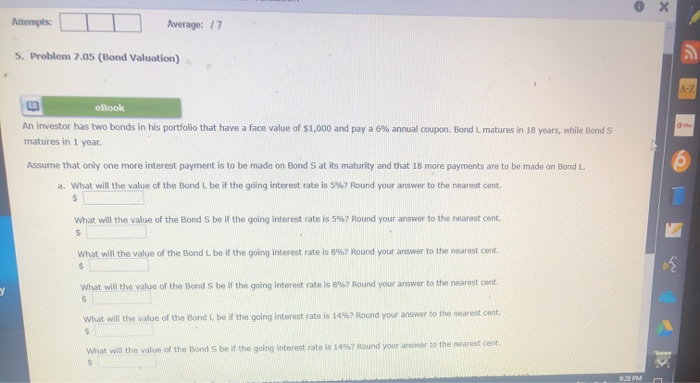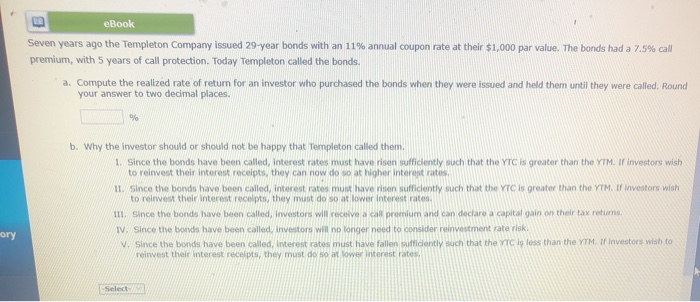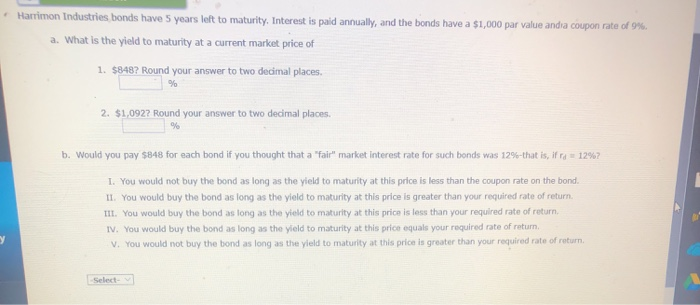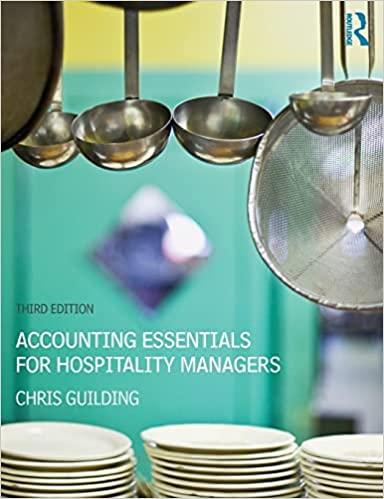Answered step by step
Verified Expert Solution
Question
1 Approved Answer
please answer all show work if possible im not finna use all my questions for 1 assigment Attempts: Average: 77 S. Problem 7.05 (Bond Valuation)
please answer all show work if possible 






im not finna use all my questions for 1 assigment
Attempts: Average: 77 S. Problem 7.05 (Bond Valuation) . eBook An investor has two bonds in his portfolio that have a face value of $1,000 and pay a 6% annual coupon. Bond L matures in 18 years, while Bonds matures in 1 year Assume that only one more interest payment is to be made on Bond S at its maturity and that 18 mare payments are to be made on Bond L. a. What will the value of the Bond L be if the going interest rate is 5%? Round your answer to the nearest cent. $ What will the value of the Bond S be if the going interest rate is 5%? Round your answer to the nearest cent. $ What will the value of the Bond L be if the going interest rate is 8%7 Round your answer to the nearest cent. $ Az What will the value of the Bond S be if the going interest rate is 8%? Round your answer to the nearest cont. $ What will the value of the Bond L be if the going interest rate is 14%? Round your answer to the nearest cent. $ What will the value of the Bond S be if the going interest rate is 14%? Round your answer to the nearest cent, S B b. Why does the longer-term bond's price vary more than the price of the shorter term bond when interest rates change? I. Long-term bonds have lower interest rate risk than do short-term bonds. II. Long-term bonds have lower reinvestment rate risk than do short-term bonds. III. The change in price due to a change in the required rate of return increases as a bond's maturity decreases IV. Long-term bonds have greater interest rate risk than do short-term bonds V. The change in price due to a change in the required rate of return decreases as a bond's maturity increases 6 An investor has two bonds in her portfolio, Bond C and Bond Z. Each bond matures in 4 years, has a face value of $1,000, and has a yield to maturity of 9.2%. Bond C pays a 11.5% annual coupon, while Bond Z is a zero coupon bond. a. Assuming that the yield to maturity of each bond remains at 9.2% over the next 4 years, calculate the price of the bonds at each of the following years to maturity. Round your answers to the nearest cent. Years to Maturity Price of Bond C Price of Bond 2 $ 4 3 2 1 0 S Select the correctoraph on the time path of prices for each bond eBook An investor purchased the following five bonds. Each bond had a par value of $1,000 and a 9% yield to maturity on the purchase day. Immediately after the investor purchased them, interest rates fell, and each then had a new YTM of 5%. What is the percentage change in price for each bond after the decline in interest rates? Fill in the following table. Enter all amounts as positive numbers. Do not round Intermediate calculations. Round your monetary answers to the nearest cent and percentage answers to two decimal places. Price 9% Price 5% Percentage Change $ % 10-year, 10% annual coupon 10-year zero 5-year Zero 30-year zero $100 perpetuity Grade it Now Save & Continue eBook Seven years ago the Templeton Company issued 29-year bonds with an 11% annual coupon rate at their $1,000 par value. The bonds had a 7.5% call premium, with 5 years of call protection. Today Templeton called the bonds. a. Compute the realized rate of return for an investor who purchased the bonds when they were issued and held them until they were called, Round your answer to two decimal places. % b. Why the investor should or should not be happy that Templeton called them. 1. Since the bonds have been called, interest rates must have risen sufficiently such that the YTC is greater than the YTM. If investors wish to reinvest their interest receipts, they can now do so at higher interest rates II. Since the bonds have been called, interest rates must have risen sufficiently such that the YTC is greater than the YTM. Ir investors with to relivest their interest receipts, they must do so at lower Interest rates 1. Since the bonds have been called, Investors will receive a cal premium and can declare a capital gain on their tax retums, IV. Since the bonds have been called, Investors will no longer need to consider reinvestment rate risk V. Since the bonds have been called, Interest rates must have fallen sufficiently such that the VTC Is loss than the YTM If investors wish to reinvest their interest receipts, they must do so at lower interest rates, ory -Select Harrimon Industries bonds have 5 years left to maturity. Interest is paid annually, and the bonds have a $1,000 par value andra coupon rate of 9%. a. What is the yield to maturity at a current market price of 1. $848? Round your answer to two decimal places. % 2. $1,0927 Round your answer to two decimal places. % b. Would you pay $848 for each bond if you thought that a "fair" market interest rate for such bonds was 12%-that is, if ra = 12%? 1. You would not buy the bond as long as the yield to maturity at this price is less than the coupon rate on the bond. II. You would buy the bond as long as the yield to maturity at this price is greater than your required rate of return III. You would buy the bond as long as the yield to maturity at this price is less than your required rate of return, IV. You would buy the bond as long as the yield to maturity at this price equals your required rate of retum V. You would not buy the bond as long as the yield to maturity at this price is greater than your required rate of return -Select- Attempts: Average: 77 S. Problem 7.05 (Bond Valuation) . eBook An investor has two bonds in his portfolio that have a face value of $1,000 and pay a 6% annual coupon. Bond L matures in 18 years, while Bonds matures in 1 year Assume that only one more interest payment is to be made on Bond S at its maturity and that 18 mare payments are to be made on Bond L. a. What will the value of the Bond L be if the going interest rate is 5%? Round your answer to the nearest cent. $ What will the value of the Bond S be if the going interest rate is 5%? Round your answer to the nearest cent. $ What will the value of the Bond L be if the going interest rate is 8%7 Round your answer to the nearest cent. $ Az What will the value of the Bond S be if the going interest rate is 8%? Round your answer to the nearest cont. $ What will the value of the Bond L be if the going interest rate is 14%? Round your answer to the nearest cent. $ What will the value of the Bond S be if the going interest rate is 14%? Round your answer to the nearest cent, S B b. Why does the longer-term bond's price vary more than the price of the shorter term bond when interest rates change? I. Long-term bonds have lower interest rate risk than do short-term bonds. II. Long-term bonds have lower reinvestment rate risk than do short-term bonds. III. The change in price due to a change in the required rate of return increases as a bond's maturity decreases IV. Long-term bonds have greater interest rate risk than do short-term bonds V. The change in price due to a change in the required rate of return decreases as a bond's maturity increases 6 An investor has two bonds in her portfolio, Bond C and Bond Z. Each bond matures in 4 years, has a face value of $1,000, and has a yield to maturity of 9.2%. Bond C pays a 11.5% annual coupon, while Bond Z is a zero coupon bond. a. Assuming that the yield to maturity of each bond remains at 9.2% over the next 4 years, calculate the price of the bonds at each of the following years to maturity. Round your answers to the nearest cent. Years to Maturity Price of Bond C Price of Bond 2 $ 4 3 2 1 0 S Select the correctoraph on the time path of prices for each bond eBook An investor purchased the following five bonds. Each bond had a par value of $1,000 and a 9% yield to maturity on the purchase day. Immediately after the investor purchased them, interest rates fell, and each then had a new YTM of 5%. What is the percentage change in price for each bond after the decline in interest rates? Fill in the following table. Enter all amounts as positive numbers. Do not round Intermediate calculations. Round your monetary answers to the nearest cent and percentage answers to two decimal places. Price 9% Price 5% Percentage Change $ % 10-year, 10% annual coupon 10-year zero 5-year Zero 30-year zero $100 perpetuity Grade it Now Save & Continue eBook Seven years ago the Templeton Company issued 29-year bonds with an 11% annual coupon rate at their $1,000 par value. The bonds had a 7.5% call premium, with 5 years of call protection. Today Templeton called the bonds. a. Compute the realized rate of return for an investor who purchased the bonds when they were issued and held them until they were called, Round your answer to two decimal places. % b. Why the investor should or should not be happy that Templeton called them. 1. Since the bonds have been called, interest rates must have risen sufficiently such that the YTC is greater than the YTM. If investors wish to reinvest their interest receipts, they can now do so at higher interest rates II. Since the bonds have been called, interest rates must have risen sufficiently such that the YTC is greater than the YTM. Ir investors with to relivest their interest receipts, they must do so at lower Interest rates 1. Since the bonds have been called, Investors will receive a cal premium and can declare a capital gain on their tax retums, IV. Since the bonds have been called, Investors will no longer need to consider reinvestment rate risk V. Since the bonds have been called, Interest rates must have fallen sufficiently such that the VTC Is loss than the YTM If investors wish to reinvest their interest receipts, they must do so at lower interest rates, ory -Select Harrimon Industries bonds have 5 years left to maturity. Interest is paid annually, and the bonds have a $1,000 par value andra coupon rate of 9%. a. What is the yield to maturity at a current market price of 1. $848? Round your answer to two decimal places. % 2. $1,0927 Round your answer to two decimal places. % b. Would you pay $848 for each bond if you thought that a "fair" market interest rate for such bonds was 12%-that is, if ra = 12%? 1. You would not buy the bond as long as the yield to maturity at this price is less than the coupon rate on the bond. II. You would buy the bond as long as the yield to maturity at this price is greater than your required rate of return III. You would buy the bond as long as the yield to maturity at this price is less than your required rate of return, IV. You would buy the bond as long as the yield to maturity at this price equals your required rate of retum V. You would not buy the bond as long as the yield to maturity at this price is greater than your required rate of return -Select Step by Step Solution
There are 3 Steps involved in it
Step: 1

Get Instant Access to Expert-Tailored Solutions
See step-by-step solutions with expert insights and AI powered tools for academic success
Step: 2

Step: 3

Ace Your Homework with AI
Get the answers you need in no time with our AI-driven, step-by-step assistance
Get Started


